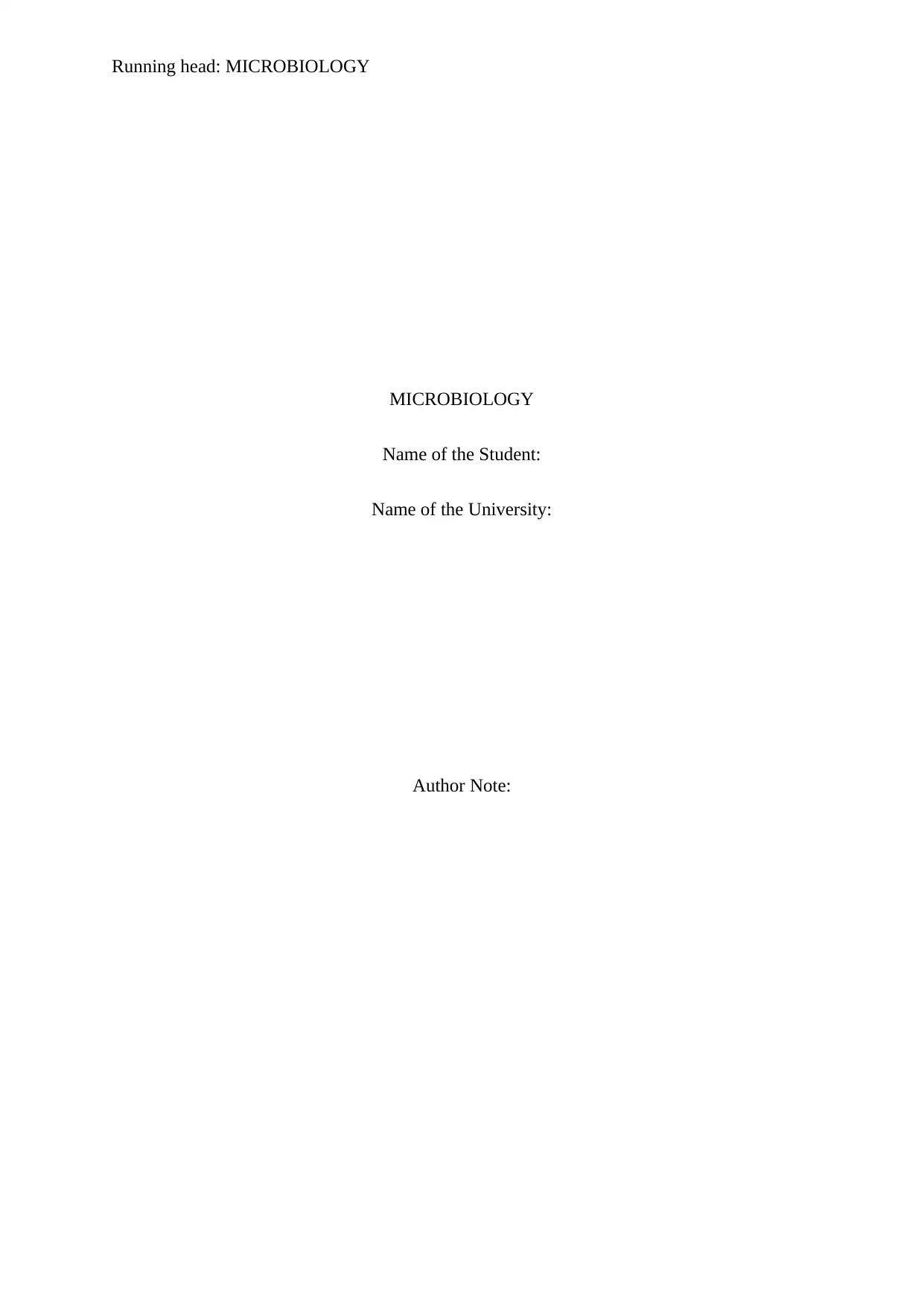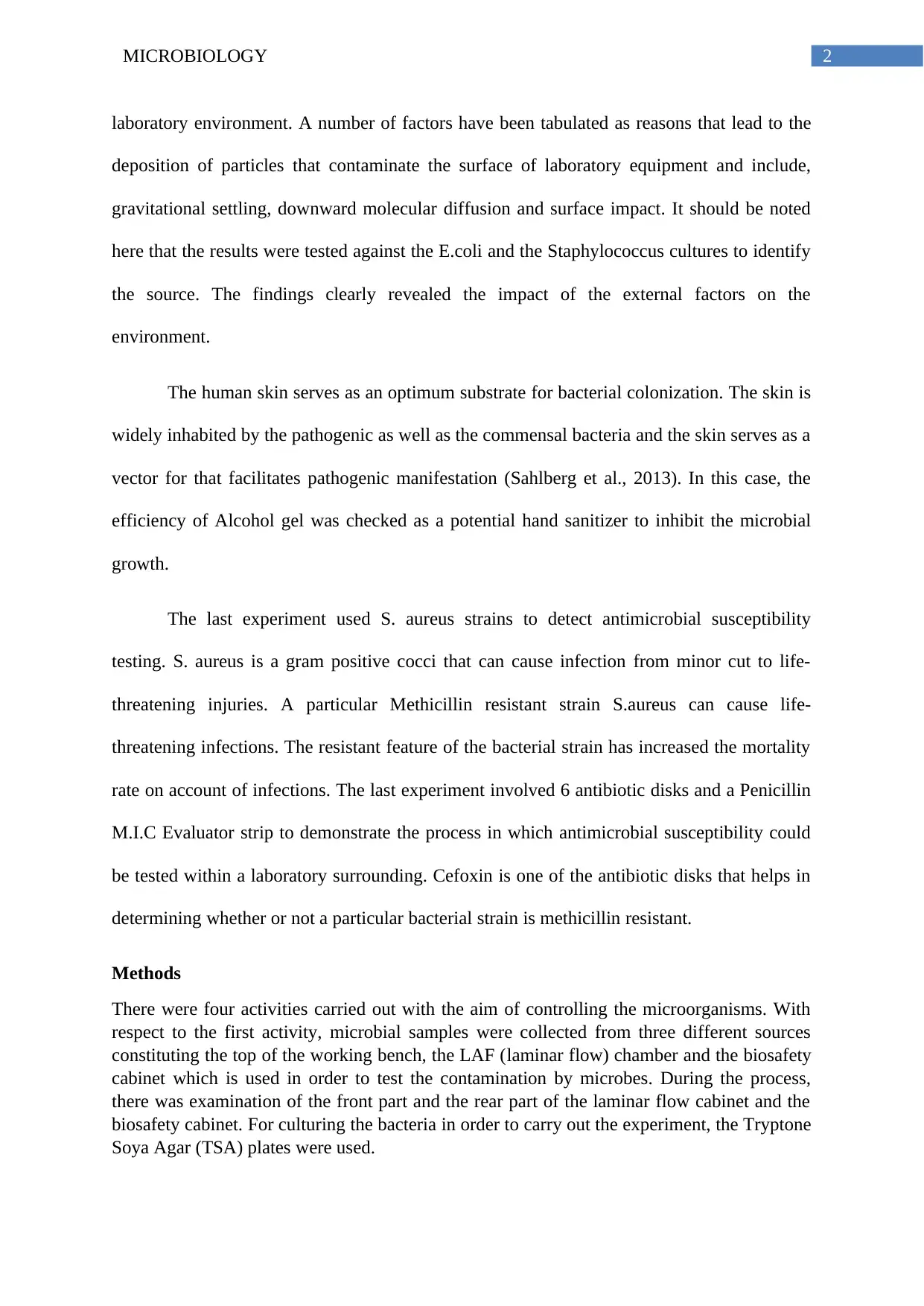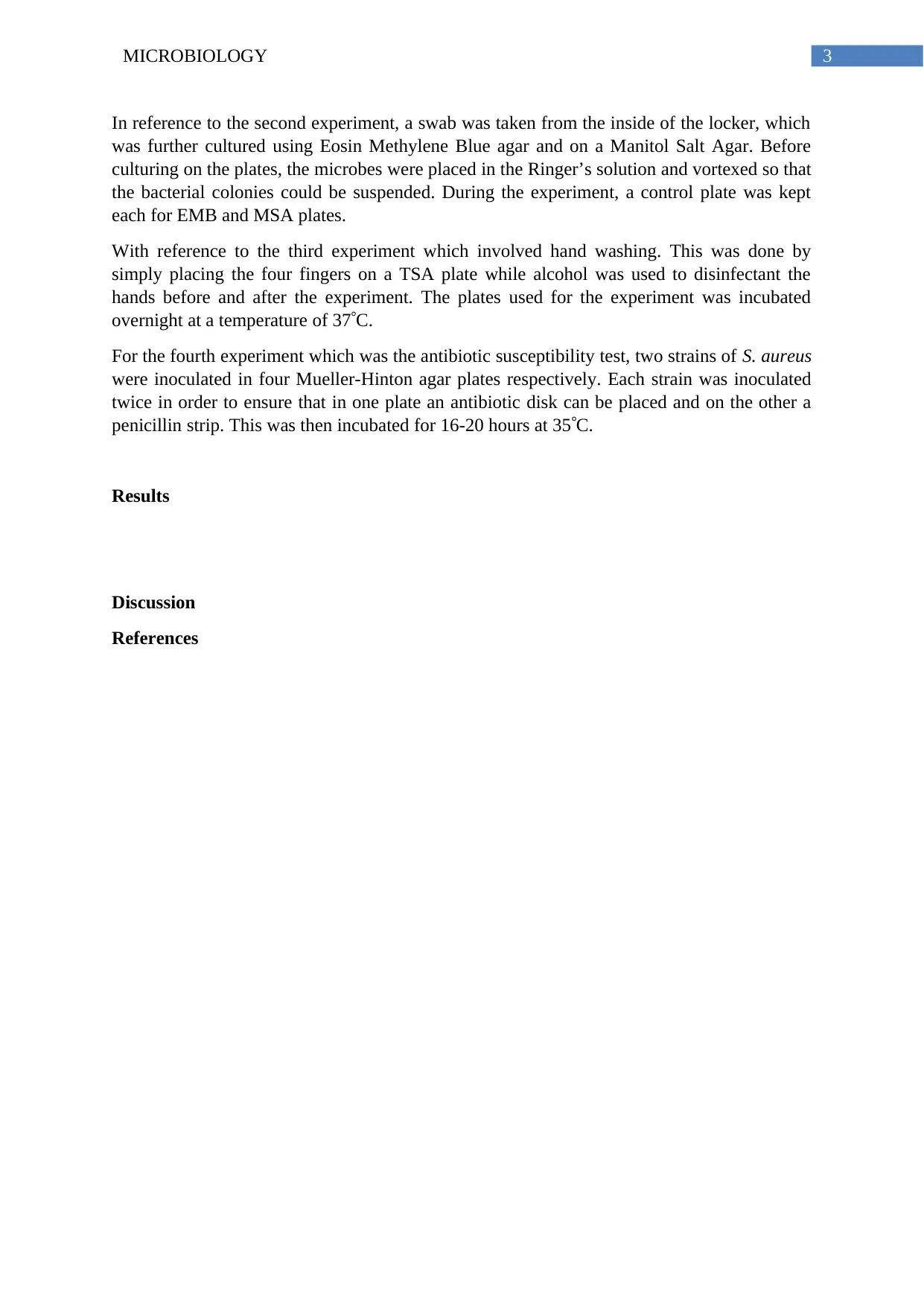Microbiology Report: Experiments on Controlling Microorganisms
VerifiedAdded on 2021/10/03
|5
|1172
|185
Report
AI Summary
This microbiology report details four experiments aimed at controlling microorganisms within a laboratory setting. The first experiment investigates the effectiveness of HEPA filters in controlling airborne bacterial contamination. The second experiment examines the deposition of bio-aerosols and airborne particles, identifying sources of contamination. The third experiment assesses the effectiveness of alcohol gel as a hand sanitizer in inhibiting microbial growth. The final experiment uses S. aureus strains to conduct antimicrobial susceptibility testing, including the use of antibiotic disks and a penicillin MIC evaluator strip to determine methicillin resistance. The report provides methods, results, and discussion for each experiment, offering insights into various techniques for controlling microbial growth and spread within a laboratory environment.

Running head: MICROBIOLOGY
MICROBIOLOGY
Name of the Student:
Name of the University:
Author Note:
MICROBIOLOGY
Name of the Student:
Name of the University:
Author Note:
Paraphrase This Document
Need a fresh take? Get an instant paraphrase of this document with our AI Paraphraser

1MICROBIOLOGY
Control of Microorganisms
Introduction:
Microbiology is the branch of Science that deals with the study of microscopic
organisms that are not visible through the naked eye. Microbes are widely distributed across
the environment and can be found in abundance in the abiotic components such as air, water
and soil (Korves et al., 2013). Different branches of microbiology deal with the different
microorganisms that affect the components of the environment. Aeromicrobiology is the
branch of microbiology that deals with the group of microorganisms that affect the quality of
air. On a broader perspective, it can be said that, these microorganisms potentially infect the
upper respiratory tract and cause infection in human beings (Masclaux et al., 2013). The first
experiment that was conducted primarily dealt with the understanding of the pathway through
which the air-borne microbes infest the human body. The study primarily focuses on
developing mechanisms that would facilitate controlling the microbial growth. The
mechanisms adapted would comprise of using antibiotics as a measure to control the
microbial growth and controlling the environmental factors that enhances microbial growth
and multiplication. It should be noted here that microorganisms that are found in the air and
are launched by agents such as an animal or a person. In this context, it should be noted here
that the first experiment analysed the quality of air as a potential contaminant within the
laboratory environment. In order to ensure the quality of air, a filtering technique was used. It
was critically examined whether or not HEPA filters were efficient in controlling the
bacterial contamination within the laboratory environment (Park et al., 2013). The
experimental outcome highlighted the potential areas through which microbial contamination
can spread at a high rate. The second experiment focused on examining the deposition of bio-
aerosols and airborne particles that serve as contaminating agents and impair the quality of
Control of Microorganisms
Introduction:
Microbiology is the branch of Science that deals with the study of microscopic
organisms that are not visible through the naked eye. Microbes are widely distributed across
the environment and can be found in abundance in the abiotic components such as air, water
and soil (Korves et al., 2013). Different branches of microbiology deal with the different
microorganisms that affect the components of the environment. Aeromicrobiology is the
branch of microbiology that deals with the group of microorganisms that affect the quality of
air. On a broader perspective, it can be said that, these microorganisms potentially infect the
upper respiratory tract and cause infection in human beings (Masclaux et al., 2013). The first
experiment that was conducted primarily dealt with the understanding of the pathway through
which the air-borne microbes infest the human body. The study primarily focuses on
developing mechanisms that would facilitate controlling the microbial growth. The
mechanisms adapted would comprise of using antibiotics as a measure to control the
microbial growth and controlling the environmental factors that enhances microbial growth
and multiplication. It should be noted here that microorganisms that are found in the air and
are launched by agents such as an animal or a person. In this context, it should be noted here
that the first experiment analysed the quality of air as a potential contaminant within the
laboratory environment. In order to ensure the quality of air, a filtering technique was used. It
was critically examined whether or not HEPA filters were efficient in controlling the
bacterial contamination within the laboratory environment (Park et al., 2013). The
experimental outcome highlighted the potential areas through which microbial contamination
can spread at a high rate. The second experiment focused on examining the deposition of bio-
aerosols and airborne particles that serve as contaminating agents and impair the quality of

2MICROBIOLOGY
laboratory environment. A number of factors have been tabulated as reasons that lead to the
deposition of particles that contaminate the surface of laboratory equipment and include,
gravitational settling, downward molecular diffusion and surface impact. It should be noted
here that the results were tested against the E.coli and the Staphylococcus cultures to identify
the source. The findings clearly revealed the impact of the external factors on the
environment.
The human skin serves as an optimum substrate for bacterial colonization. The skin is
widely inhabited by the pathogenic as well as the commensal bacteria and the skin serves as a
vector for that facilitates pathogenic manifestation (Sahlberg et al., 2013). In this case, the
efficiency of Alcohol gel was checked as a potential hand sanitizer to inhibit the microbial
growth.
The last experiment used S. aureus strains to detect antimicrobial susceptibility
testing. S. aureus is a gram positive cocci that can cause infection from minor cut to life-
threatening injuries. A particular Methicillin resistant strain S.aureus can cause life-
threatening infections. The resistant feature of the bacterial strain has increased the mortality
rate on account of infections. The last experiment involved 6 antibiotic disks and a Penicillin
M.I.C Evaluator strip to demonstrate the process in which antimicrobial susceptibility could
be tested within a laboratory surrounding. Cefoxin is one of the antibiotic disks that helps in
determining whether or not a particular bacterial strain is methicillin resistant.
Methods
There were four activities carried out with the aim of controlling the microorganisms. With
respect to the first activity, microbial samples were collected from three different sources
constituting the top of the working bench, the LAF (laminar flow) chamber and the biosafety
cabinet which is used in order to test the contamination by microbes. During the process,
there was examination of the front part and the rear part of the laminar flow cabinet and the
biosafety cabinet. For culturing the bacteria in order to carry out the experiment, the Tryptone
Soya Agar (TSA) plates were used.
laboratory environment. A number of factors have been tabulated as reasons that lead to the
deposition of particles that contaminate the surface of laboratory equipment and include,
gravitational settling, downward molecular diffusion and surface impact. It should be noted
here that the results were tested against the E.coli and the Staphylococcus cultures to identify
the source. The findings clearly revealed the impact of the external factors on the
environment.
The human skin serves as an optimum substrate for bacterial colonization. The skin is
widely inhabited by the pathogenic as well as the commensal bacteria and the skin serves as a
vector for that facilitates pathogenic manifestation (Sahlberg et al., 2013). In this case, the
efficiency of Alcohol gel was checked as a potential hand sanitizer to inhibit the microbial
growth.
The last experiment used S. aureus strains to detect antimicrobial susceptibility
testing. S. aureus is a gram positive cocci that can cause infection from minor cut to life-
threatening injuries. A particular Methicillin resistant strain S.aureus can cause life-
threatening infections. The resistant feature of the bacterial strain has increased the mortality
rate on account of infections. The last experiment involved 6 antibiotic disks and a Penicillin
M.I.C Evaluator strip to demonstrate the process in which antimicrobial susceptibility could
be tested within a laboratory surrounding. Cefoxin is one of the antibiotic disks that helps in
determining whether or not a particular bacterial strain is methicillin resistant.
Methods
There were four activities carried out with the aim of controlling the microorganisms. With
respect to the first activity, microbial samples were collected from three different sources
constituting the top of the working bench, the LAF (laminar flow) chamber and the biosafety
cabinet which is used in order to test the contamination by microbes. During the process,
there was examination of the front part and the rear part of the laminar flow cabinet and the
biosafety cabinet. For culturing the bacteria in order to carry out the experiment, the Tryptone
Soya Agar (TSA) plates were used.
⊘ This is a preview!⊘
Do you want full access?
Subscribe today to unlock all pages.

Trusted by 1+ million students worldwide

3MICROBIOLOGY
In reference to the second experiment, a swab was taken from the inside of the locker, which
was further cultured using Eosin Methylene Blue agar and on a Manitol Salt Agar. Before
culturing on the plates, the microbes were placed in the Ringer’s solution and vortexed so that
the bacterial colonies could be suspended. During the experiment, a control plate was kept
each for EMB and MSA plates.
With reference to the third experiment which involved hand washing. This was done by
simply placing the four fingers on a TSA plate while alcohol was used to disinfectant the
hands before and after the experiment. The plates used for the experiment was incubated
overnight at a temperature of 37C.
For the fourth experiment which was the antibiotic susceptibility test, two strains of S. aureus
were inoculated in four Mueller-Hinton agar plates respectively. Each strain was inoculated
twice in order to ensure that in one plate an antibiotic disk can be placed and on the other a
penicillin strip. This was then incubated for 16-20 hours at 35C.
Results
Discussion
References
In reference to the second experiment, a swab was taken from the inside of the locker, which
was further cultured using Eosin Methylene Blue agar and on a Manitol Salt Agar. Before
culturing on the plates, the microbes were placed in the Ringer’s solution and vortexed so that
the bacterial colonies could be suspended. During the experiment, a control plate was kept
each for EMB and MSA plates.
With reference to the third experiment which involved hand washing. This was done by
simply placing the four fingers on a TSA plate while alcohol was used to disinfectant the
hands before and after the experiment. The plates used for the experiment was incubated
overnight at a temperature of 37C.
For the fourth experiment which was the antibiotic susceptibility test, two strains of S. aureus
were inoculated in four Mueller-Hinton agar plates respectively. Each strain was inoculated
twice in order to ensure that in one plate an antibiotic disk can be placed and on the other a
penicillin strip. This was then incubated for 16-20 hours at 35C.
Results
Discussion
References
Paraphrase This Document
Need a fresh take? Get an instant paraphrase of this document with our AI Paraphraser

4MICROBIOLOGY
References:
Korves, T. M., Piceno, Y. M., Tom, L. M., DeSantis, T. Z., Jones, B. W., Andersen, G. L., &
Hwang, G. M. (2013). Bacterial communities in commercial aircraft high‐efficiency
particulate air (HEPA) filters assessed by PhyloChip analysis. Indoor air, 23(1), 50-
61.
Masclaux, F. G., Sakwinska, O., Charrière, N., Semaani, E., & Oppliger, A. (2013).
Concentration of airborne Staphylococcus aureus (MRSA and MSSA), total bacteria,
and endotoxins in pig farms. Annals of occupational hygiene, 57(5), 550-557.
Park, D. U., Yeom, J. K., Lee, W. J., & Lee, K. M. (2013). Assessment of the levels of
airborne bacteria, gram-negative bacteria, and fungi in hospital lobbies. International
journal of environmental research and public health, 10(2), 541-555.
Sahlberg, B., Gunnbjörnsdottir, M., Soon, A., Jogi, R., Gislason, T., Wieslander, G., ... &
Norback, D. (2013). Airborne molds and bacteria, microbial volatile organic
compounds (MVOC), plasticizers and formaldehyde in dwellings in three North
European cities in relation to sick building syndrome (SBS). Science of the total
environment, 444, 433-440.
References:
Korves, T. M., Piceno, Y. M., Tom, L. M., DeSantis, T. Z., Jones, B. W., Andersen, G. L., &
Hwang, G. M. (2013). Bacterial communities in commercial aircraft high‐efficiency
particulate air (HEPA) filters assessed by PhyloChip analysis. Indoor air, 23(1), 50-
61.
Masclaux, F. G., Sakwinska, O., Charrière, N., Semaani, E., & Oppliger, A. (2013).
Concentration of airborne Staphylococcus aureus (MRSA and MSSA), total bacteria,
and endotoxins in pig farms. Annals of occupational hygiene, 57(5), 550-557.
Park, D. U., Yeom, J. K., Lee, W. J., & Lee, K. M. (2013). Assessment of the levels of
airborne bacteria, gram-negative bacteria, and fungi in hospital lobbies. International
journal of environmental research and public health, 10(2), 541-555.
Sahlberg, B., Gunnbjörnsdottir, M., Soon, A., Jogi, R., Gislason, T., Wieslander, G., ... &
Norback, D. (2013). Airborne molds and bacteria, microbial volatile organic
compounds (MVOC), plasticizers and formaldehyde in dwellings in three North
European cities in relation to sick building syndrome (SBS). Science of the total
environment, 444, 433-440.
1 out of 5
Your All-in-One AI-Powered Toolkit for Academic Success.
+13062052269
info@desklib.com
Available 24*7 on WhatsApp / Email
![[object Object]](/_next/static/media/star-bottom.7253800d.svg)
Unlock your academic potential
Copyright © 2020–2025 A2Z Services. All Rights Reserved. Developed and managed by ZUCOL.
